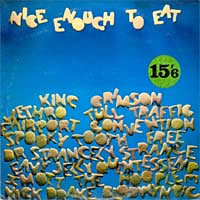| Nice Enough to Eat | ||||
|---|---|---|---|---|
 | ||||
| Compilation album by Various Artists | ||||
| Released | November 1969 | |||
| Genre | Rock | |||
| Length | 55:22 | |||
| Label | Island IWPS 6 | |||
| Producer | Various | |||
| Series chronology | ||||
| ||||
Nice Enough to Eat is a budget priced sampler album released by Island Records in 1969.
Contents
Continuing the policy set by its predecessor You Can All Join In , the album presented tracks from the latest albums by established artists including Free, Traffic, and Jethro Tull, and introduced tasters from newer signings to the label, notably Nick Drake and King Crimson. The inclusion of the Nick Drake track, "Time Has Told Me", has been credited with providing the first opportunity for many record buyers to hear Drake's music. [1]
It was priced as low as 14 shillings and 6 pence (£0.72), less than half of the standard album price at the time. The album is described at Allmusic.com as a "somewhat incoherent sampler of folk-rock, prog rock, and prog-tinged hard rock", but with a "stellar artist lineup". [2]
It was combined with You Can All Join In for a CD re-release in August 1992 entitled Nice Enough To Join In (Island Records IMCD 150), but omitting tracks 1, 4 (side one) and 4 (side two).